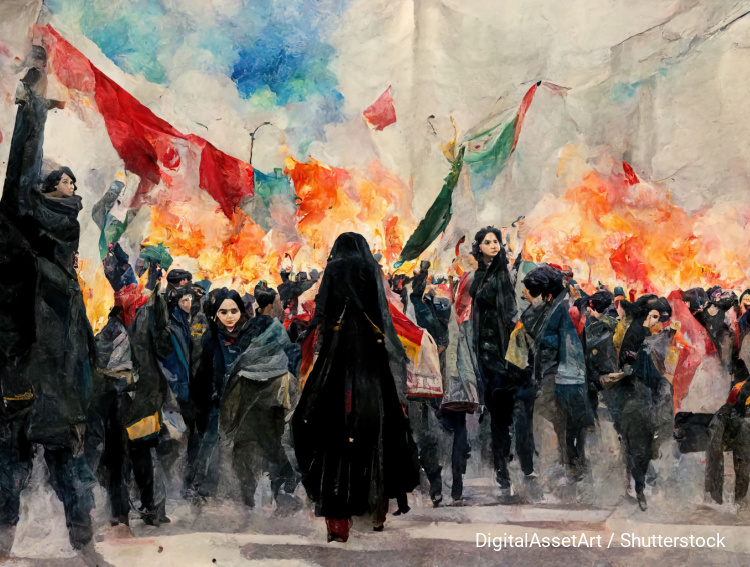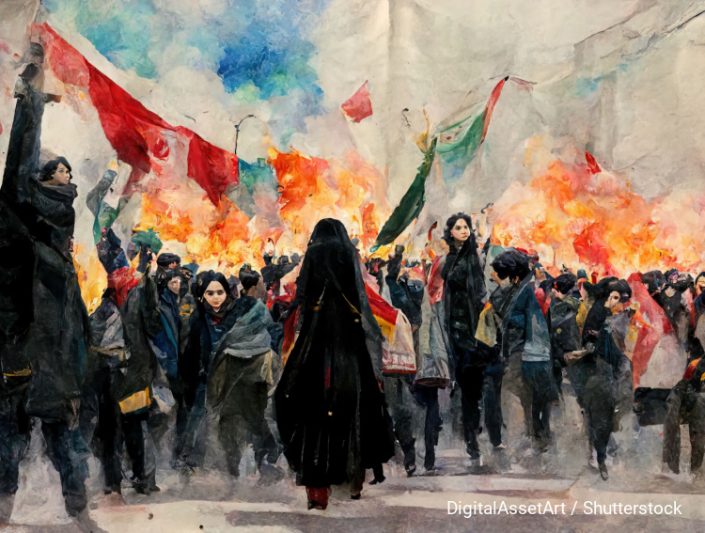By Mahtab Mahboub
Independent journalists, especially female journalists, in Iran are seen to present a potential threat to the state by just reporting on social realities from their perspective. They are the child in “The Emperor’s New Clothes” who blurts that the king is actually wearing nothing but empty rhetoric!
According to the International Federation of Journalists (IFJ), since the beginning of – the unrest in Iran following the death of Mahsa Amini on 16 September 2022, at least 55 journalists have been arrested for reporting on protests across the country and human rights abuses by the state. Iran is now “the world’s third biggest jailer of journalists”, following China and Myanmar, according to Reporters Without Borders.

#Iran🇮🇷: More than 55 journalists have been arrested since the beginning of the protests. We urge the authorities to free all media workers imprisoned and to stop using the national uprising as a tool to suppress independent media. #EndImpunity @RFERL https://t.co/zDNi6Y2bqi
— IFJ (@IFJGlobal) December 15, 2022
Among those arrested are Elahe Mohammadi and Niloofar Hamedi who drew attention to Mahsa Amini’s, (also known as Jina Amini) death after lying in a coma while in “morality police” custody, and Nazila Maroufian, who later interviewed Jina’s father in which he stated that his daughter “had no previous illnesses that could be to blame for her death”. Niloofar’s photo of Jina’s parents crying as their daughter died on a hospital bed, published on Twitter, was the first report about the case. Elahe’s report from Jina’s funeral inspired many to raise their voice against injustice to women. Nazila’s interview titled “They are lying!” gave a platform to a victim of state violence and disrupted the monopoly of the state over the narrative of Jina’s death.
But who are these brave journalists?
Elahe Mohammadi
Three years ago, Elahe Mohammadi spent a night behind the walls of Rajayi-Shahr prison just outside the city of Karaj to document and narrate stories of the execution of prisoners or their forgiveness by the victim’s next of kin under retribution law. This is what her husband reminded us on the 75th day of her arrest, hoping that Elahe had not heard of the news of Majidreza Rahnavard’s execution. Rahnavard, 23, was hanged in December after a court convicted him of “enmity against God” for stabbing to death two members of the paramilitary Basij Resistance Force.
On 29 September 2022, security forces arrested Elahe Mohammadi, a reporter for the daily newspaper Hammihan. She had traveled to Saqqiz, Jina (Mahsa) Amini’s hometown to cover her funeral on the 17th September in which thousands of people chanted “Jin, Jian, Azadi” (woman, life, freedom) for the first time. In a report published in Hammihan newspaper, she quoted Jina’s parents asking for people’s solidarity and defending their right to seek justice for their daughter. Just for doing her job as a journalist, she was summoned by the security forces and arrested on her way to the police station. She was then taken to the notorious Evin prison and charged as an agent of the CIA. However, this is not the first time she was punished for reporting on the suffering of women. In April 2020, following her reporting on the conditions of women in Qarchak Prison – where she, herself is now being held – in the days of the Coronavirus outbreak, and protests regarding the downing of the Ukraine International Airlines Flight 752 in January 2020 by Islamic Revolutionary Guard Corps (IRGC), the IRGC sued her and she was accused of spreading lies to “disturb the public mind”. She was banned from writing in the media for a year.
Niloofar Hamedi
“The first thing that occurred to me was to call Niloofar and ask her to write about the suspicious “suicide” of a forest ranger in our city, then I remembered she is in prison”, writes an environmental activist in a small city in north Iran. On 28 April 2022 Niloorfar published a video which showed morality police officers shooting a couple in a park in Tehran after an argument over hijab laws. She had previously reported on honour killings and violence against women and was among the very first to write about sexual harassment in the media. She was very active within the Iranian #metoo movement and wrote many articles on the suffering as well as power of women who came forward with their stories. On the 100th day of her arrest, her husband Tweeted: “I am in the middle of my eighteen-week marathon preparation, Niloofar has also jogged with the ugly prison slippers; on both sides of this wall, we won’t abandon life, our love is more powerful than the darkness.” Niloofar practices yoga in prison and has even made a challenge of repeating “Sun Salutation” 30 times in a row. Many, including some fellow female journalists, have joined her challenge and post about it on their social media.
Nazila Maroufian
On 4 January during her court procedure, Nazila Maroufian fainted and was taken to hospital. A Kurdish journalist and student at Allameh University in Tehran, 24 year-old Nazila is also from Saqqez, like Jina. She was fully aware of the risk of publishing her interview with Jina’s father. In a Tweet she thanked Mostaghel online for publishing the interview and wrote “as I publish this, I want everybody to know that I don’t have any health issues and I don’t intend to kill myself!” She was hinting at the state attempts to stage killings of dissents and protestors as suicides, including through making televised “confessions” – recorded under torture and psychological pressure – of family members who confirm the suicide of their loved ones in front of cameras of “interrogator-journalists”. Nazila knew she could be arrested and now we know that her life is in danger, like many courageous women who tried to speak the truth and expose the regime’s lies. She has faced extreme psychological torture during the more than two months of illegal arrest to make forced confessions, which she has resisted so far.
The choice to give voice to the most oppressed through journalism should not be punished by imprisonment, torture and brutality.
While the state-run media is increasingly losing its audience and legitimacy among Iranians, the Persian speaking broadcasters from outside Iran as well as social media outlets have increasingly become sources of information for people. But inside the country, the life and destiny of these daring journalists remain in the hands of judges of “revolutionary courts” with no access to independent lawyers. However, they have proven that their voices, their passion for life and their fight for “woman, life, freedom” is unstoppable, despite all the pressures.
Photo Credits: DigitalAssetArt / Shutterstock

